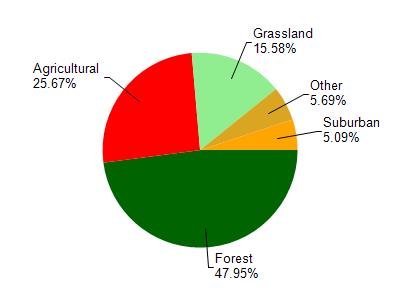Monroe
Yes
No
No
Fish and Aquatic Life
Overview
Farmers Valley Creek, located in west central Monroe County, flows in a northwesterly direction for approximately 11.5 miles before reaching the La Crosse River immediately downstream of Perch Lake in Sparta. The stream has a moderate gradient of 44 feet per mile and drains gently rolling agricultural and forested land. Several large springs in the upper reaches of the creek contribute cool water temperatures ideally suited for successful trout spawning. Farmers Valley Creek is a Class I trout stream for the 10.4 miles above STH 71 and Class II for the 1.0 mile below STH 71.
The most recent fish and habitat survey, conducted in 1981, documented cool, clear water with a bottom comprised mostly of sand and silt with lesser amounts of gravel and rubble. Moderate to severe bank erosion was noted in the lower and middle sections of this stream due to high water and excessive livestock grazing. In-stream cover was limited to log and brush tangles, undercut banks, and overhanging grasses. Many long deep pools found throughout the stream also provided cover for fish. The 1981 fish survey documented self-sustaining populations of brown trout and brook trout. Rock bass and some forage fish species were also documented. Land acquisition and in-stream habitat improvements are recommended for the entire stream system. A fish and habitat survey of Farmers Valley Creek should be conducted to document the current status of the stream. The creek hasn’t been stocked since 1978 when browns were planted. Access is possible from several road crossings, DNR owned land adjacent to Farmers Valley Creek off CTH AA and DNR owned easements. The Elroy-Sparta Bike Trail crosses the upper end of the stream, then runs parallel to it until Sparta.
Date 2002
Author Aquatic Biologist
Condition
Wisconsin has over 84,000 miles of streams, 15,000 lakes and milllions of acres of wetlands. Assessing the condition of this vast amount of water is challenging. The state's water monitoring program uses a media-based, cross-program approach to analyze water condition. An updated monitoring strategy (2015-2020) is now available. Compliance with Clean Water Act fishable, swimmable standards are located in the Executive Summary of Water Condition in 2018. See also the 'monitoring and projects' tab.
Reports
Management Goals
Wisconsin's Water Quality Standards provide qualitative and quantitative goals for waters that are protective of Fishable, Swimmable conditions [Learn more]. Waters that do not meet water quality standards are considered impaired and restoration actions are planned and carried out until the water is once again fishable and swimmable
Management goals can include creation or implementation of a Total Maximum Daily Load analysis, a Nine Key Element Plan, or other restoration work, education and outreach and more. If specific recommendations exist for this water, they will be displayed below online.
Monitoring
Monitoring the condition of a river, stream, or lake includes gathering physical, chemical, biological, and habitat data. Comprehensive studies often gather all these parameters in great detail, while lighter assessment events will involve sampling physical, chemical and biological data such as macroinvertebrates. Aquatic macroinvertebrates and fish communities integrate watershed or catchment condition, providing great insight into overall ecosystem health. Chemical and habitat parameters tell researchers more about human induced problems including contaminated runoff, point source dischargers, or habitat issues that foster or limit the potential of aquatic communities to thrive in a given area. Wisconsin's Water Monitoring Strategy was recenty updated.
Grants and Management Projects
| Project Name (Click for Details) | Year Started |
|---|
|
|
Monitoring Projects
| WBIC | Official Waterbody Name | Station ID | Station Name | Earliest Fieldwork Date | Latest Fieldwork Date | View Station | View Data |
|---|
| 1659400 | Farmers Valley Creek | 423069 | Farmer Valley Creek - 10 Ct Rd | 5/13/1979 | 11/6/1979 | Map | Data |
| 1659400 | Farmers Valley Creek | 10014146 | Farmers Valley Creek Station 1 - East Ave. Bridge Near La Crosse River | 5/14/2019 | 10/10/2019 | Map | Data |
| 1659400 | Farmers Valley Creek | 10010104 | Farmers Valley Creek - Farmers Valley Cr. Station #1 100 Feet Below I-90 Bridge | | | Map | Data |
| 1659400 | Farmers Valley Creek | 10013144 | Farmers Valley St. 1-05 Confluence With La Crosse River | 1/1/2015 | 1/1/2015 | Map | Data |
| 1659400 | Farmers Valley Creek | 10014151 | Farmers Valley Creek Station 1 - Golf Course Rd. | | | Map | Data |
|

Watershed Characteristics
Farmers Valley Creek is located in the Little La Crosse River watershed which is 240.79 mi². Land use in the watershed is primarily forest (48%), agricultural (25.70%) and a mix of grassland (15.60%) and other uses (10.80%). This watershed has 445.88 stream miles, 114.59 lake acres and 5,439.88 wetland acres.
Nonpoint Source Characteristics
This watershed is ranked High for runoff impacts on streams, Not Ranked for runoff impacts on lakes and Low for runoff impacts on groundwater and therefore has an overall rank of Low. This value can be used in ranking the watershed or individual waterbodies for grant funding under state and county programs.However, all waters are affected by diffuse pollutant sources regardless of initial water quality. Applications for specific runoff projects under state or county grant programs may be pursued. For more information, go to surface water program grants.